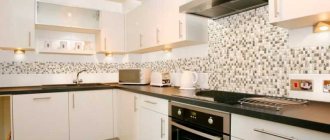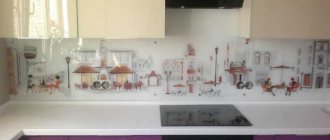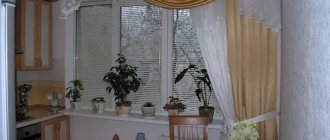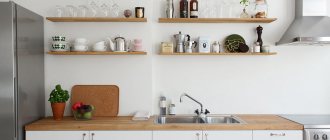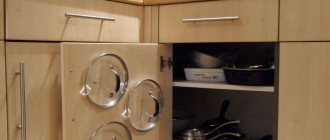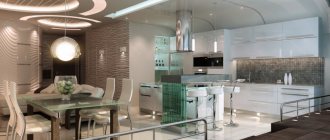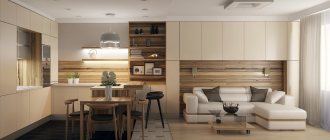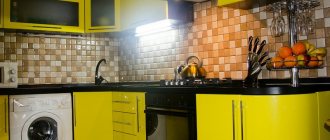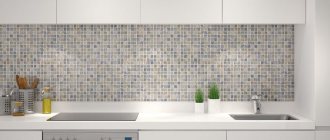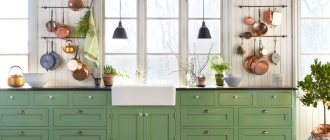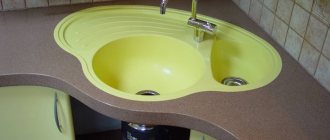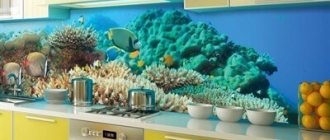Apron requirements
Based on its purpose, a kitchen apron should have the following characteristics: not attract dirt and dust, easy to clean, have a long service life, not be afraid of moisture and detergents, light rays, and look beautiful.
Purpose of glass panels
The skinali is a glass apron that is attached to the wall in the work area from the table to the upper cabinets. This part of the wall quickly becomes dirty with splashes from boiling and frying food. Due to high temperatures and high humidity, dirt and grime eat into the surface, leaving greasy stains even after removal.
It is the glass apron and ceramic tiles that protect the walls from contamination. But, unlike tiles, skinals have better performance characteristics and are available in a wide range to suit every taste.
The height of the apron varies between 40-60 cm, but options are possible when the working surface reaches 1-2 m, depending on the location of furniture, household appliances, and room design.
Apron materials
Historically, it was made from ceramic tiles. But choosing tiles of the required color or pattern is quite difficult; very often it was necessary to equip this area with just white squares and decorate the surface manually.
Therefore, other materials began to be used to decorate the work area: PVC wall panels, metal.
But tempered glass is more popular.
Varieties of design
The glass panel can have different designs and is made in the following ways:
- Budget option: without color or pattern. A transparent apron without a color pattern is chosen to protect a wall covered with paint or wallpaper from splashes. If you don't like the smooth glass surface, it can be sandblasted or chemically etched. The result will be satin (frosted) glass.
Transparent protection Source insideakwaibom.com
- Made from plain colored glass. The laconic monochromatic surface has a stylish look and can serve as an accent in the kitchen design. Light shades will add volume, bright shades will add a note of cheerfulness to the atmosphere, and contrasting shades will tie together interior details and accessories. It’s nice that you can choose almost any color - the palette of available shades is inexhaustible.
Single-color tinting Source c-di.kiev.ua
- Stemalite (or enamel, enameled glass). A layer of opaque ceramic paint is applied to one side of the tempered glass. The paint is burned into the glass surface and becomes an inseparable part of it. The enamel is applied to transparent or tinted glass, thereby achieving various decorative effects. The stomalite layer is reliable and durable, it is difficult to damage even with a knife.
Enameled glass Source hdinterior.ru
- With photo printing. A full-color image is applied to the back of the glass surface using a UV printer. The drawing looks bright and as realistic as possible, which is why photo printing is the leader in popularity. The panel with photo printing is durable: the UV layer does not fade, is not afraid of moisture and can withstand heating up to 120°. The panel with a 3D effect looks impressive, but such pleasure is more expensive.
Drawing made using photo printing Source 2gis.ru
- With vinyl film. A budget option for designing a work area. The design is printed on clear vinyl self-adhesive and then rolled onto the inner surface of the skin. The decorative film is protected from moisture and temperature changes, but there is a non-zero chance that over time it will begin to fade and peel off.
The film is reliably protected by glass Source dekor-td.ru
- Mirror apron. Glass for a kitchen backsplash with a mirror layer is valuable because it creates the illusion of enlarging the room. To make the work area look like a single whole, it is important to cover the entire surface with a mirror. If you do this only on part of the wall (for example, just above the sink or near the stove), the effect will disappear, the space will look “cut up”.
The best way to increase space Source el.decoratex.biz
- Illuminated with LED strip. Whatever the material and image of the apron, properly selected lighting will enhance its decorative effect. There is a second plus: the working surface will be illuminated by the main and reflected light, significantly saving electricity. The tape is attached around the perimeter of the panel, less often inside. LED RGB strips can change color, which increases their design capabilities.
With lighting Source forum.leroymerlin.pl
See also: Catalog of companies that specialize in completing unfinished houses
Advantages of a glass apron
In addition to the general requirements for an apron, glass products are a completely environmentally friendly material, they are particularly decorative and unique, they are combined with all other finishing materials, and you can use such an apron immediately after installation.
It perfectly reflects light rays, so the kitchen will be bright and light, and the space with such a product will visually increase.
Tempered glass cannot be accidentally broken and has a long service life.
A glass apron with photo printing allows you to create any design at the request of its future owner. The transparent surface will perfectly show the finishing of this area, making the apron an almost invisible surface.
A glass apron will allow you to provide additional illumination of the work area without unnecessary problems.
Note!
- U-shaped kitchen: pros and cons of the U-shaped layout. Methods of arranging furniture, dividing into working and dining areas. Photos and videos of design ideas
Kitchen facades: TOP 180 photos and video reviews of kitchen facades. Types of frames, criteria for choosing materials and color solutions
- Short curtains for the kitchen - features of using short curtains in small and large kitchens. Advantages and disadvantages of fabric materials (photo + video)
Practical glass is easy to clean with plain water and is not afraid of liquid detergents. A surface with a pattern can make droplets of water and fat almost invisible.
The glass apron can be made in one piece, without seams.
The simplest glass splashback will cost significantly less to install than most other surfaces.
Laminated glass (triplex)
A complex coating consisting of 2-3 canvases glued together using a special polymer film, thanks to which you can decorate the product with any images.
Triplex has the best performance qualities, being particularly durable and resistant to high temperatures. If damaged, it does not crumble into fragments. It has a complex and lengthy manufacturing process and is considered the most expensive option.
Disadvantages of a glass apron
Making kitchen splashbacks from glass requires careful measurement of not only the height and length, but also the holes for sockets, pipes and other communication elements. It will be almost impossible to cut anything out later.
It is better to entrust the installation of the apron to professionals; before installation, the wall will have to be carefully leveled.
Note!
Water filter for the kitchen: functions and benefits of a water filter in the kitchen. Types of filters and mechanisms, their pros and cons (photo + video)Kitchen in high-tech style: 135 photos and video master class on organizing space and design
Kitchen in modern style - 160 photos of the best design options and features of the style
All dirt will be clearly visible on the glass, so the product will have to be washed almost daily. Although a clean kitchen has never harmed anyone.
How to choose glass for an apron?
Typically, the thickness of glass for such purposes is 4, 5, 6 or 8 millimeters.
Where glass may be subject to mechanical stress, as well as temperature changes, near the stove or at the sink, it is necessary to install special tempered glass, which is 500% more reliable than usual, but even if it breaks, the fragments will be safe even for small children.
Tempered glass is not afraid of temperature overloads, and fits perfectly next to the stove. Simple glass does not have such reliability, but breaks into large dangerous pieces.
Do not confuse silicate glass with organic glass - these are different materials. At its core, plexiglass or polymethyl methacrylate is an acrylic resin, a thermoplastic transparent plastic known as plexiglas, acrylic, acrylate and others. This material has found its application in many areas of life: the aviation industry, military engineering, plumbing, advertising, medicine, tourism, music, construction and so on. If you want to make an apron for the kitchen from plexiglass, then it cannot be installed next to the stove (it melts under the influence of temperature), it is easily scratched (soft material), it is difficult to clean (compared to silicate glass, it is quite porous), and in general, in the role This type of glass is difficult to imagine for kitchen decoration.
As a starting material for kitchen aprons, two types of glass are common: regular (M1, green, unbleached, standard, transparent) and clarified (optics, optiwhite, clear, luxury, white, bleached, cleared, bleached). They differ from each other in color rendition. Regular thick glass has a slight greenish tint, which is most noticeable against a white or light background. Lightened glass does not have this tint, so printing or painting white or light colors on it looks whiter and the shades are purer. This effect is achieved by reducing the iron content during the production of clarified glass.
The thicker the unbleached glass, the more noticeable the green tint is; for example, on 4mm glass it will be less pronounced than on 6 or 8mm glass. For backsplashes with a light image, cleared glass (optiwhite, clearvizion or crystalvizion brands) is a good option. Ordinary glass has a slight greenish tint, which is difficult to distinguish on a colored backsplash, but is noticeable against a white background (the white color of a kitchen backsplash distorts the greenish tint that is present in the thickness of the glass). In the photo on the left is bleached glass, on the right is normal glass.
Discolored glass, thanks to its unique transparency properties, will make the pattern on the apron bright and rich, and the colors purer, but for this pleasure you will have to overpay about 30%. Apart from color rendition, there are no differences between glasses: both types are equally well processed, tempered, and can be printed or painted.
Matte aprons
Frosted glass can be smooth or textured. An excellent design for a matte apron will be various patterns applied using sandblasting techniques.
In this way you can make inscriptions or patterns, simple drawings.
Note!
Kitchen studio - 155 photo examples of how to make a large kitchen stylish, spacious and comfortableKitchen sink: 130 photos of choosing a model and do-it-yourself sink installation features
MDF kitchen apron: advantages and disadvantages of the material. Varieties of MDF aprons. Features of external decoration. DIY installation instructions (photo + video)
Aprons with photo printing
Kitchen aprons made of glass with photo printing have become the most popular type of wall decoration for the work area. In this case, the selected image is drawn with special paints on the back of the glass.
The 3D effect will help make the image three-dimensional and alive, visually increase the space of the room, and create the effect of a panoramic window.
Manufacturing materials
Kitchen aprons are made of tempered glass. It is distinguished by increased strength (10 times more reliable than usual), protection from injury in case of damage, and fire resistance.
Subtypes of material are considered:
- Stemalite (enamel), which is painted before hardening.
- A skinal where an image is applied to a vinyl backing using photo printing.
- Optiwhite, which lacks the greenish tint usual for ordinary glass. This option is required for models with a light pattern.
- Satin is frosted glass with a rough surface. Some difficulty in care is compensated by its appearance, which is similar to velvet fabric.
It is worth considering that in tempered glass all holes are made in advance. Therefore, after installation, it will no longer be possible to add space for a hook or socket.
Plexiglas is considered a cheaper option. It is distinguished by less demanding installation and the ability to drill holes as needed. A significant disadvantage is the rapid loss of appearance, especially after contact with cleaning agents.
Illuminated apron
The glass apron will become even prettier and lighter with additional lighting.
To do this, LED strips are laid around the perimeter of the product. Such devices will not consume a lot of electricity, but will provide an unusual design.
Ribbons can be white or have different colors. The colored ribbons can be changed as desired, giving the kitchen a slightly different mood each time.
You can control the backlight with a regular switch, touch sensor or remote control.
LED strips are installed in a special profile or glued to the bottom of wall cabinets. If transparent glass is used, the LEDs are installed in a wall covered with a panel.
Apron styles
Transparent glass without a pattern will emphasize the beauty of the applied wallpaper, a white apron will be an excellent addition to a classic kitchen, black and white images will complement the high-tech style, art deco will be advantageously emphasized by fantasy images, matte skinnels are perfect for the techno style, clear glass will fill the loft, and ethnic Decorate with cute pictures with thematic views.
Installation of a glass apron
Installing such an apron is a troublesome and difficult task. So it is better to entrust this work to professionals. Not only are they responsible for the integrity of the coating, but they will also install it perfectly evenly and ensure the tightness of the apron space.
The advantage of glass will be its installation after the kitchen has been completely finished, so that the beautiful completion of the renovation will coincide with the completion of the installation work, and you can begin to use the home catering unit. The process itself will take an hour and a half, which is much faster than tiling.
There are three options for attaching a glass apron: using special fasteners, profile systems, or liquid nails.
The first option does not require leveling the wall and will be the most reliable method, but will slightly worsen the appearance.
The second method will allow you to place the wires without additional gating of the walls, but will require high-quality rough finishing.
Liquid nails will be the most unreliable, but fastest way to attach a glass apron.
A glass apron will perfectly complete the decoration of the kitchen and can become the most charming element of kitchen decoration. This will be proven by a photo of a glass kitchen apron.
Which glass is suitable for an apron?
The kitchen work area is subject to significant (and sometimes unexpected) loads, so for reasons of durability and safety, tempered glass (Stalinite) is preferred. It is recommended to install an apron made of heat-resistant stalinite (7-10 times stronger than ordinary glass) near the stove.
A very strong blow can break tempered glass. At the same time, it will break into small fragments with blunt edges that are not capable of causing serious problems. Understanding the importance of the question of what kind of glass a kitchen apron is made from, most companies use glass 6-8 mm thick. There are other types of glass for kitchen skins:
- Triplex. The material consists of two layers of silicate or tempered glass, bonded with a polymer film. Thanks to this layer, upon impact, the apron does not break into fragments, but becomes covered with cracks. At the request of the customer, the film is made transparent or decorative (with a pattern). In the kitchen, triplex skins are not often found due to the high cost of the material and the complexity of installation (difficulties with installing roof rails and cutouts for sockets).
Bright poppies for a good mood Source opora-stroy.ru
- Plexiglas. The name hides acrylic - a plastic that can be tinted and painted. The material is environmentally friendly, durable and lightweight (weighs 2 times less than glass), but it is prohibited to install it behind the hob. When heated above 80°, it begins to deform.
- Polycarbonate. It is distinguished by its budget cost and durability. The only drawback is that under the influence of ultraviolet radiation it becomes cloudy, turns yellow and becomes brittle. It is better to choose a brand that contains UV stabilizers.
Made from plexiglass Source innofashion.ru
When choosing a material for an apron, you need to take into account the fact that tempered glass comes in two types:
- Float glass (M1, display case). It seems absolutely transparent, but in thickness it acquires a pronounced greenish “bottle” tint. The effect does not appear on an apron with bright, saturated colors. But, if a landscape or still life is made in light colors (or on a light background), a greenish tint can negate all the beauty.
- Lightened (bleached, Optiwhite). Glass from which all iron oxides, which give a greenish tint, have been chemically removed. It acquires special transparency and is suitable for skinnals in pastel colors. The only disadvantage of the material is its price, 30% more expensive than usual.
Float glass is suitable for this range Source mekskinali.ru
See also: Catalog of companies that specialize in the development and implementation of interior redevelopment of a private house
